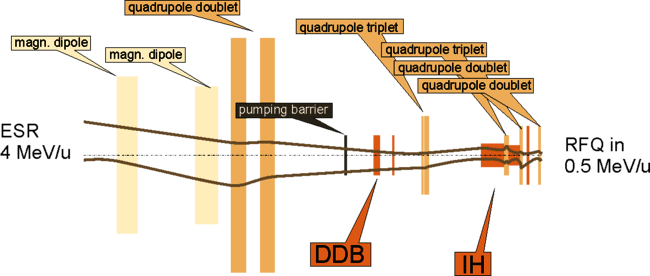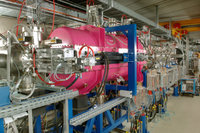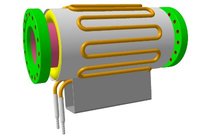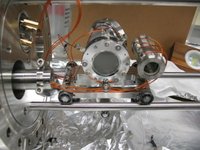
To decelerate the ions that left the ESR from 4 MeV/u down to 6 keV/u a linear decelerator has been built. It consists of three main components, a double drift buncher (DDB), an interdigital H-type (IH) structure and a radiofrequency quadrupole (RFQ) as shown schematically above. The beam arrives in a one microsecond macro bunch and is first bunched to fit the 108 MHz time structure of the decelerator structures most efficiently. Then it is decelerated in the IH to about 0.5 MeV/u, rebunched and injected in the RFQ. The RFQ reduced the particles’ energy further to 6 keV/u, suitable to capture them electrically in flight in the Cooler Penning trap.

The ion beam is guided through the decelerator by magnetic dipoles D, quadrupole doublets QD, and triplets QT. As shown above the ions have to be bended first into the HITRAP beam line by two dipoles and then focused through a pumping barrier P that separates the vacua of ESR and HITRAP. Then it is injected into DDB and IH. To keep the beam together during deceleration there is one quadrupole triplet lens inside the IH. The matching into the transversal phase space of the RFQ is then done with two quadrupole doublets. The beam is steered with magnetic steerers and detected on Faraday cups, scinitillating YAG crystal screens, and wire grids.
Ion optical calculations have been performed to optimize the beam transport as well as the deceleration. Different codes where used and one example of a COSY infinity calculation is shown in the figure above from the ESR at the left to the RFQ input side on the right separately for the horizontal h and vertical v beam components. The IH has been optimized using LORASR and the RFQ with PARMTEQ and DYNAMION.
The Double Drift Buncher
To bunch the beam efficiently two consecutive drift tube bunchers at 108 and 216 MHz bunch the beam.
HITRAP Cooler Penning Trap
Electron cooling of highly charged ions (HCI) in a Penning Trap
Electron cooling of highly charged ions (HCI) in a Penning Trap
Dieser Text existiert momentan nur auf Englisch.
A crucial part of the HITRAP facility is the so-called Cooler Trap, the end-point of the decelerator. After the Interdigital H-type (IH) Linac and Radio Frequency Quadrupole have decelerated the bunch to 6 keV/u, the ions can be injected into this Penning Trap where they are cooled down to 10 eV or even further down to 4 K, i.e. the temperature of the setup.
For this challenging task a 400-mm, long cylindrical trap is necessary. 21 inner electrodes allow the formation of axial nested traps and therefore the simultaneous confinement of both positive and negative charges. 109 electrons are indeed used to perform electron cooling of the hot ion sample down to 10 eV, when the process is stopped to avoid excessive recombination. Further cooling is accomplished via resistive cooling, dissipating in an external tank circuit the image current induced on the electrodes by the moving ion cloud. The theoretical limit is the temperature of the environment which is kept in thermal contact with the 6-T superconducting magnet at 4 K.
The cooled sample is then extracted either in bunched or slow, quasi-continuous mode according to the needs of the experiments.
EBIT Test Ion Source
Dieser Text existiert momentan nur auf Englisch.
At GSI a new generation of EBIT devices – the Dresden EBIT type – is operated as a test ion source for the HITRAP decelerator project to supply experiments with close to real ion species for commissioning. The ions produced by that source will be sent to the Cooler Penning trap investigating its operation as well as to the experiments.
This source is typically operated with gaseous elements but since some experiments require different species for tests, charge breeding in this small, room temperature EBIT became necessary. One example is the use of Ca14+ ions for laser spectroscopy of the forbidden fine structure transition 2s22p23P0 – 3P1, which serves as a test for the hyperfine spectroscopy planned for H and Li-like ions as will be supplied by HITRAP.










